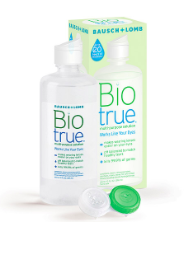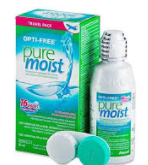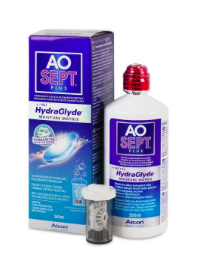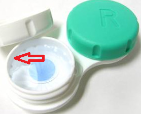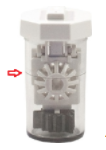Hybrid Contact Lenses
Your Complete Guide to Hybrid Contact Lenses
What are hybrid contact lenses?
The Synergeyes Ultrahealth hybrid contact lenses represent the largest jump in lens technology for decades. Incorporating both the highly oxygen permeable soft outer skirt of the lens, which holds the hard RGP centre portion of the lens off the eye. This combination gives you the best of both lens types – the comfort of a soft lens, and the clear vision of a hard lens.
How are Hybrid contact lenses made?
Similarly to soft lenses, hybrid lenses use a lathe cut technique, however one major difference is that the material they are cut from already has the hard centre and the soft skirt. These two materials are bonded together using their proprietary technology to stop them coming apart after being cut and hydrated.
Are hybrid lenses comfortable to wear?
If you have specific visual requirements i.e. the need to see clearly and comfortably without fluctuating vision, irregular astigmatism, keratoconus, pellucid marginal degeneration (PMD) or post-LASIK ectasia (just to name a few), then RGP lenses provide better optical correction than soft lenses which wrap to your eye. However, despite providing better vision, RGP’s are not as comfortable and can take some time (and expense) to get an optimal fitting and acceptable comfort. RGP lenses are also not ideal in dry, dusty or windy environments.
Thankfully the new hybrid lens design provides a sealed system where a well of lubricant makes the lens very comfortable and provides better resistance to dryness and foreign bodies getting under the lens. Hybrid contact lenses provide the best of both worlds, the comfort of a soft lens with the fantastic clear vision of an RGP lens.
How do hybrid contact lenses correct vision?
Hybrids are specifically designed to restore vision to patients with the many types and stages of keratoconus. Because the lens design vaults over the cornea, there’s minimal risk of corneal scarring, making hybrid lenses a healthy treatment option for keratoconus.
In addition, the soft skirt of the hybrid design helps to center the contact lens over the visual axis regardless of where the cone is located on the cornea or how large it is, thereby decreasing visual distortions and providing superior vision. The hybrid design also prevents dirt from getting under the lens and will not pop out unexpectedly. No other contact lens available today can provide all of these benefits in a single product.
How long do hybrid contact lenses last?
We recommend replacement every 6 months. Whilst they may last a bit longer than this, the lens surface becomes harder to clean and the lens less comfortable. Also, wearing a lens past this point can lead to reaction to the buildup of deposits on the lens surface making contact lens wear in future more difficult.
Daily wear time:
Many people find they are most comfortable if they limit lens use to 8-10 hours per day. The maximum lens wearing time varies between people but it may be possible to wear a lens for 12-14 hours per day.
How do I insert my hybrid lenses?
1. Wash your hands with a mild, moisturiser free soap and dry them with a clean towel.
2. Fill the lens with TheraTears Gel while holding it horizontally on a DMV® inserter OR by stabilizing the lens between your index and middle finger OR by using a tripod method. If you find the Gel too thick or if you notice dried gel on your eyelashes, try to insert the contact lenses with Theratears Drops instead. It is critical to fill the lens bowl completely to the top to avoid insertion bubbles, which result in blurred vision.
3. Lean forward until your nose is perpendicular to the floor, and tuck your chin to your chest. It may be helpful to place a mirror flat on the counter to look into as you insert the lens.
4. Look downwards, and pull up on your upper eyelid by placing the fingers at the base of the lashes. Look up, then pull down on the lower lid with the ring finger of the hand holding the lens/DMV inserter.
5. Look at the centre of the lens as it approaches your eye, then gently apply the lens directly to the centre of the eye. It is very important not to push the lens too forcefully onto the eye.
How do I remove my hybrid lenses?
1. Do not put any lubricating drops or solution into the eye prior to removal. Be sure your hands are completely dry before attempting to remove your lenses to optimize the gripping effect of the fingers on the edge of the lens.
2. Look down, then pull your upper eyelids upwards using your left forefinger. Then look up, and pull your lower eyelid down, using your right middle finger.
3. Looking slightly up, place your right index finger and thumb on the left and right edges of the lens.
4. Using the pads of your fingers, not your fingernails, apply a firm enough pinch (using your right index finger and thumb) to grab onto the edge of the lens. This allows air to get beneath the soft skirt to release the lens from the surface of the eye. Slowly pull the bottom edge of the lens away from your eye.
5. If your fingers become wet from removing the first lens, be sure to completely dry them again before removing the other lens.
How to take care of your lenses – General tips for successful contact lens wear
Always wash your hands before handling your contact lenses or eyes
Wash with soap and running water, remembering to rinse your hands thoroughly. Dry your hands with a towel. Ensure your nails are clean and not too long. Use non-cosmetic soap as soaps with lotions or oils in them can transfer to the contact lens and cause irritation on lens application along with blurred vision.
Cleaning of your contact lenses
It is important to clean your hybrid contact lenses daily to maintain the highest standards of comfort and visual clarity. Each day after you remove your lenses, you must clean them prior to overnight storage.
ALWAYS use the prescribed cleaning solution, which serves as a cleanser and disinfectant. It also increases the comfort of your contact lenses.
NEVER use saliva, saline or water of any type. Tap, distilled and bottled water (and particularly saliva) contain bacteria and viruses which may be absorbed by the contact lens and cause eye infections. Sterile saline is NOT a disinfectant nor are contact lens rewetting drops.
1. For rinsing your lenses, use only BioTrue or Optifree Puremoist.
2. Place the lens bowl-side up in the palm of your hand and apply a few drops of biotrue. With the pad of your finger gently rub the entire lens in a circular motion against the palm of your hand. Be sure to thoroughly clean the entire lens and then rinse it well in a steady stream of biotrue.
3. For disinfection use AOSept Disinfection System. Carefully follow the instructions for the disinfection system you use. Always soak lenses in the provided lens case for at least 6 hours prior to inserting into the eye, We recommend you do it overnight.
4. Use only the case provided with the AOSept disinfection system. Be sure to soak the lenses a minimum of 6 hours before
inserting again. Never put AOSept directly into the eye. Never rinse lenses with AOSept prior to insertion into the eye. Solution must be neutralized. Never use AOSept® Plus in a flat lens case.
5. Always use fresh solution when storing your lenses. Never “top off” or use old solution. Old solution should NEVER be re-used.
6. Do NOT allow the tip of the solution bottle to come into contact with any surface and keep the solution bottle tightly closed when not in use.
7. Always discard the old lens case to avoid contamination and ensure proper neutralization.
8. Never dry out your lenses with a tissue or a towel as it will scratch the front and back surfaces of the lenses, making them uncomfortable and decreasing your quality of vision.
Expiry date of solution
Always check the expiry date of the solution. When you open a new bottle, write the date you need to discard it (generally 3 months after opening) on the container in a felt tip pen. Do not use out-of-date solution.
Contact lens cases
Bacteria can accumulate in contact lens cases. After putting in your contact lenses, the case should always be emptied, rinsed out with cleaning solution
(Biotrue or Optifree) – NEVER water – then wiped with a clean tissue and air-dried. A new contact lens case is included with every purchase of contact lens cleaning solution. Always throw away the old case and use the new one. Contact lens cases should be replaced if damaged or cracked. Only fill the case with solution to the top of the line, as if over-filled, the lens may ride up and be damaged by the lid.
Never wear a contact lens for longer than it is designed for
The use of the contact lenses past these dates is NOT recommended as the lenses are not structurally or functionally designed to last any longer. The material often breaks down after this date, causing irritation and poor vision.
Do not sleep in your contact lenses
You should remove hybrid lenses before sleeping. Stagnation of the tear layer behind the lens could lead to a higher risk of eye infection. Since most of the people who need hybrid lenses have already had some trouble with their eyes, further challenge to the surface of the eye would not be advisable.
Swimming and Water sports
The safest option is to wear goggles and thoroughly disinfect the lens afterwards. Water contains germs, which may then contaminate the contact lens. Wearing your contact lenses after these activities would be the same as wearing your wet swimsuit. In the event you get water splashed in your eyes, make sure to remove your lenses and clean them thoroughly.
It is not recommended to swim in fresh water even if it’s flowing freely due to the risk of infection from Acanthamoeba, which can cause severe loss of vision.
Contact lens use when in hospital or unwell
Avoid wearing contact lenses in hospital or while unwell. Hospitals are sources of infection. When you are sick (even just with a cold or flu) you risk spreading infection to your eye via contact lenses.
Avoid wearing contact lenses on a plane
The humidity in aircraft cabins is very low. If you wear your contact lenses they will become very dry and uncomfortable and you will arrive at your destination with sore eyes. Please wear your spectacles for flying.
When travelling
Use a smaller size bottle of solution, do NOT transfer solutions into small containers.
FAQ’s
What are the normal adaptation symptoms I can expect?
While you are first getting used to your lenses you may notice some or all of the following:
- Variable vision due to increased tear production
- Stinging, itching and abnormal blinking
- Lens edge awareness particularly felt with your eyelids
- Increased glare sensitivity – wear sunglasses
- Initial discomfort with lots of close work/computer work – use more lubricant eye drops
- Dryness in air-conditioning and smoky areas – use more lubricants and try cleaning your lenses mid way through the day
- You may also notice a slight blur to your vision when you wear spectacles straight after removing your contact lenses. This should clear within 30 minutes.
What is abnormal?
Persistent redness, discomfort, pain, blurred vision or if bright lights hurt your eyes. If these occur stop all lens wear and make an appointment to see us. “If in doubt take your lenses out.”
Why can I see a white ring in my hybrid contact lenses?
At about the 4-5 month mark of wearing your Synergeyes ultrahealth or duette hybrid contact lenses you may notice a white ring start to form at the junction of the hard central portion of the lens and the soft outer skirt. This represents a buildup of calcium within the lens and is commonly caused by your tear chemistry and use of the hydrogen peroxide based cleaners like AOSEPT. This represents a cosmetic issue, as it does not affect the vision or comfort of the lens. The calcium is built up within the material itself so it is not on the surface.
How do I fix this white ring?
Replace the lenses
Synergeyes recommends replacement of the hybrid lenses at the 6 month mark. We are able to offer a special 2 pack price which represents a 30% discount from the price of buying each pair separately (lenses must be ordered together to obtain the discount but can be supplied after the 1 month follow up visit).
Change your cleaning solution (next time)
If you have noticed this occur it may be best to shift to a non hydrogen peroxide based cleaning solution such as Bausch and Lomb BioTrue. However this won’t get rid of a white ring already in the lens – it may just reduce its occurrence next time.
One of my contact lenses is suddenly uncomfortable, what should I do?
The first thing to do is to take the lens out. If this fixes the problem, it is probably due to the lens rather than your eye itself. Now clean the lens thoroughly and put it back in. If that fixes the problem then there might have been something on the lens. If not then remove the lens again.
Now you need to carefully examine the edge of the lens in bright light. You might notice a small tear or nick out of the edge of the lens. The lens would need to be replaced so please contact us.
In the above scenario if you remove the lens but your eye is still hurting, it is likely that there is something wrong with your eye. That means it would be best to come and see us straight away to have it checked.
Aftercare schedule for your lenses
We normally like to see you about 1-4 weeks after picking up your lenses and then again at 3 months, 6 months and at least every 6 months thereafter. This is so we can review the health of your eyes and suggest any improvements in your contact lens prescription, lens design or material. If you do not return for regular aftercare checks we are legally unable to supply you with contact lenses, as they are a health appliance.
Always wear your contact lenses to your contact lens appointments, having had them in for at least 2 hours and remember to bring your case and spectacles with you.
Costing
Initial examination – $299
> includes initial and follow up appointment, trial contact lenses, teaching insertion and removal of contact lenses, starter multipurpose solution cleaning kit,
Cost of hybrid contact lenses
$750 for a pair of lenses
Please note, all prices are a supply for both eyes and are subject to change at any time.
Warranty
You have 3 months to change the parameters until we find the perfect fitting for your eyes. We offer a 50% CREDIT if lens is unsuccessful. Sorry, we do not provide warranty for loss of lenses.
What happens if I break a lens?
New lenses are covered by a warranty against breakage for the first 3 months. Please note: you will need to ensure you return the broken lens). After this time we will replace the lens to the same prescription at a 30% discount.
Should I keep a spare set on hand?
It is a good idea to have a spare set of lenses on hand because a new set can take 10-14 days to be made. We can offer a 30% discount on all duplicate lenses purchased. Please speak to your Optometrist for further details.
Refunds
We can give a 50% CREDIT on hybrid contact lenses. Please note we do not give refunds on fitting fees. Please see our office policy or speak to your optometrist for further details.
Book an eye test with us
Thinking about transitioning from glasses to contact lenses? Or just want to find out if hybrid contact lenses are right for you? Book an appointment with us today!
